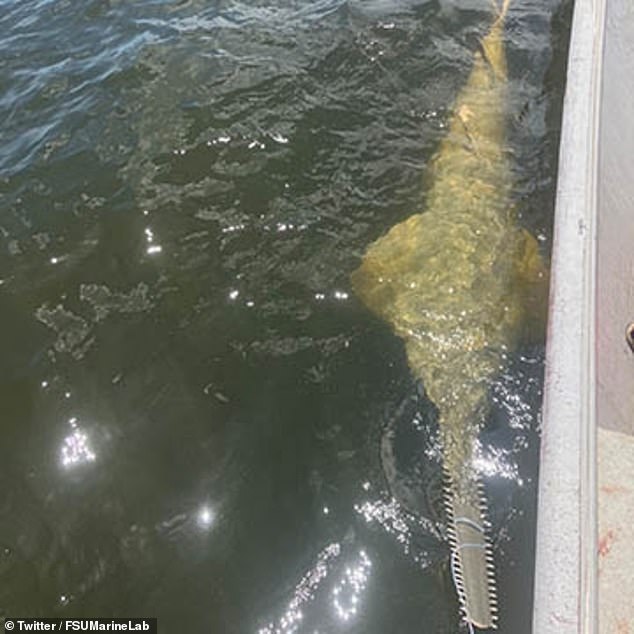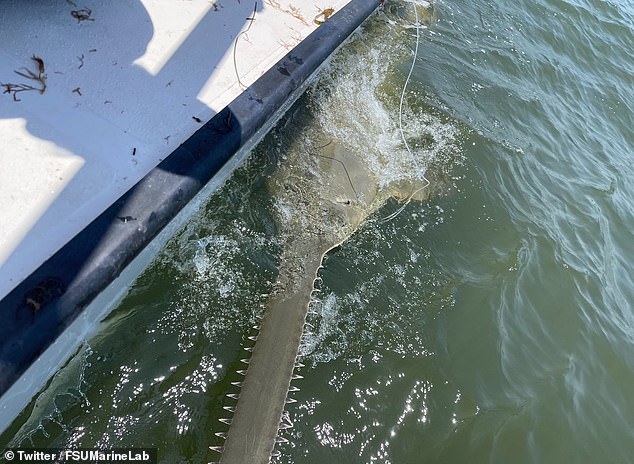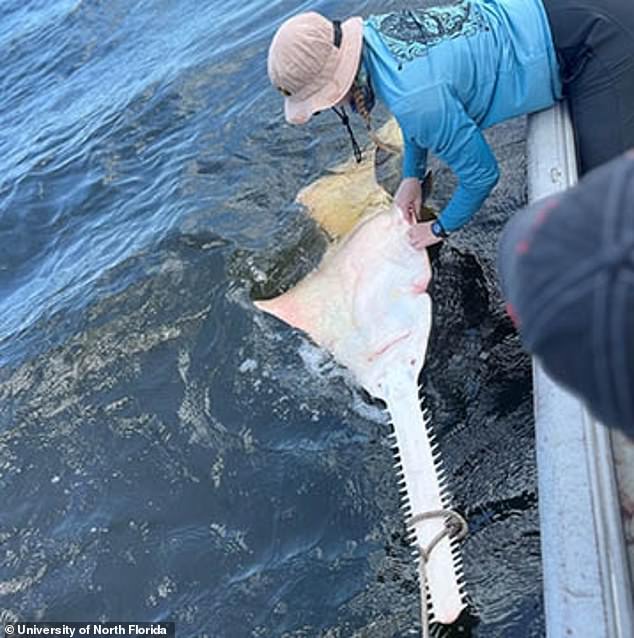Dr. Jim Gelsleichter and members of the University of North Florida Shark Biology Program were shocked after capturing and releasing a critically endangered sawfish.
He and four UNF students were exploring the St. Marys River when they found this rare, 10-foot-long shark relative this summer.
One of his students discovered the sawfish, a species that evolved from primitive sharks that are now extinct, after feeling a tug on their line while in the water.
Gelsleichter, director of UNF’s Shark Biology Program, jumped into the water to grab the line they used to catch large species.
“It was the heaviest thing I’d ever pulled off a drum line. When I did it, I thought, ‘Wouldn’t it be funny if it was a sawfish?'” Gelsleichter said. USA today.
Dr. Jim Gelsleichter and members of the University of North Florida Shark Biology Program captured and released a sawfish on July 16.

Jim Gelsleichter, director of UNF’s Shark Biology Program, jumped into the water to grab the line they used to catch large species and save the sawfish.
Gelsleichter and the students on the 21-foot boat immediately began studying the fish after pulling it out of the water on July 16.
Shark enthusiasts identified the sawfish as a male because it had claws and paired pelvic fin extensions that male sharks use to reproduce, according to the UNF news release.
They also determined that the sawfish was subadult, meaning it was young and not fully mature.
After observing highly calcified and soft claws, the UNF professor and the students concluded the age of the sawfish.
Several scientists, including UNF biologists who have studied sawfish reproduction, confirmed that male sawfish typically do not fully mature until they are at least 11 feet long.

Gelsleichter and the students concluded that the sawfish was a subadult male, meaning it was not fully mature.
Gelsleichter was excited by this find in part because of the massive decline in the sawfish population since the 20th century.
Some of the main reasons behind the decline in sawfish population are their frequent capture in fishing gear and habitat decline.
They were also the first marine fish to be listed as endangered under the US Endangered Species Act in 2003.
‘Sawfish were known to occur in northeast Florida before population declines led to the species being listed as endangered,’ he said.
‘The reappearance of the sawfish in our area is a positive sign of population recovery.’
Although the smalltooth sawfish population has increased since experts labeled the species endangered, it is at risk of declining again due to reports of sawfish deaths in Florida, according to the UNF news release.
Hundreds of fish, including more than 50 sawfish, have died in the Florida Keys from a type of whirling disease, which can cause fish to spin and act abnormally.
According to Gelsleichter, the sawfish they encountered during their trip did not show any symptoms of whirling disease.

The discovery of the sawfish came less than six months after more than 50 of them died in Florida due to a disease that causes turbulence and whirlpools.
Sawfish are known for their elongated, saw-like snouts, which they cut laterally through the water when hunting species.
There are five different species of sawfish: smalltooth, bigtooth, dwarf, green, and narrow.
Each of these five species is different in size, geographic distribution, and physical characteristics such as the location of the dorsal fin and the shape of the caudal fin.
Smalltooth sawfish generally live in tropical seas and estuaries of the Atlantic Ocean.
This species of sawfish feeds primarily on fish, but can eat various invertebrates such as shrimp and crabs.
Their snouts also have an electrosensory system that allows them to identify prey and detect the weak amount of electricity produced by other animals.
Floridians hoping to spot a smalltooth sawfish will have a good chance of doing so if they are on the southwest coast near the Everglades region and the Florida Keys.
Anyone outside the U.S. can find smalltooth sawfish off the coasts of Honduras, Belize, Cuba, Guinea Bissau, and Sierra Leone.
Smalltooth sawfish typically live between 25 and 30 years, but largetooth sawfish can live between 30 and 80 years.
(tags to translate)dailymail

